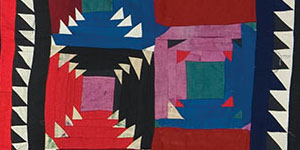
The majority of kurak (patchwork) patterns are formed utilizing combinations of triangles and squares, which when combined in various ways, form strips and medallions of patterns that are assembled to make larger patterns. The most common examples are black (or sometimes colored) triangles on white, which are called by many names: red-footed falcon, little amulet (tumorcha), crane (turna), and butterfly (pasha parak), to name a few. Black triangles on a white background were most common in Kyrgyzstan and Tajikistan. A general good luck charm as well as a symbol of feminine fertility, the triangle or tumar is evident in all areas of applied art.
The introduction of black and red factory cloth originating from the Russian annexation of Central Asia in the eighteenth and nineteenth centuries is probably a key factor in the development of the kurak form we see today. In remote Tajik villages women bought white fabric and dyed it black until the mid-twentieth century. It was thought that each color had its own individual meaning but the most powerful combination against the evil eye was black and white. Black and white patterns in Tajikistan are called balodurkunak, meaning “making evil far away.”
While scant information exists on the symbolic meaning of color in Central Asia, it has been suggested that red personified the source of life, joy, victory, and fertility and yellow was the symbol of well-being, wealth, and ancestral spirits. Some linked yellow to the sun, fire, and ancient solar deities. There were more variations in the combinations of colors in the north, while black and white with yellow predominated in the south.